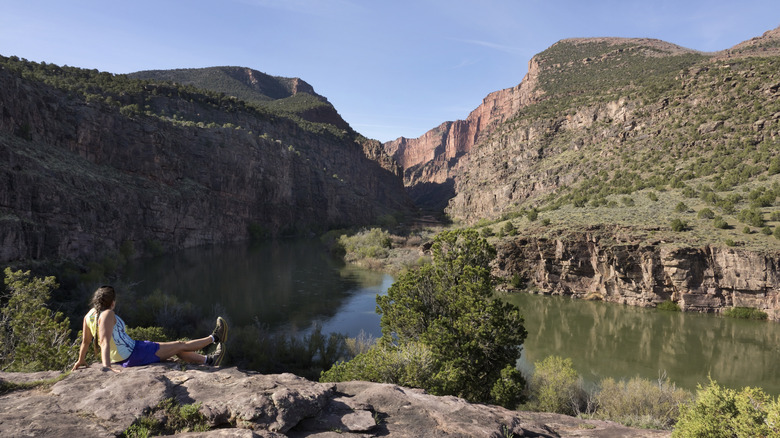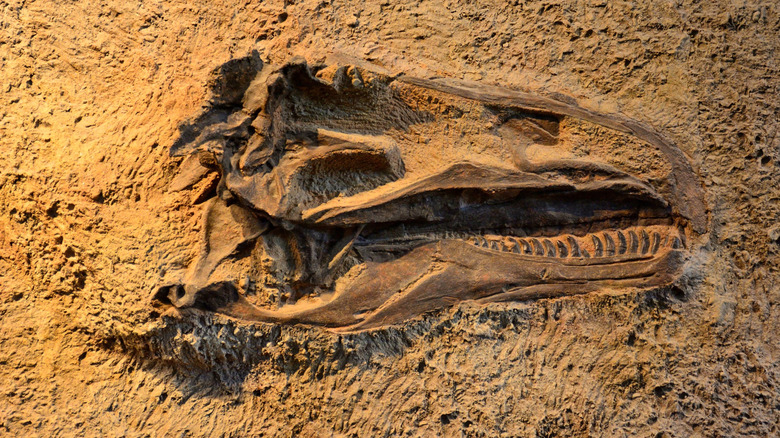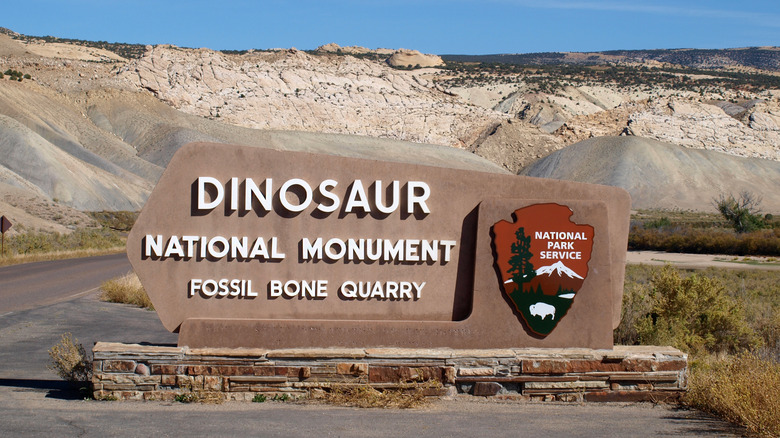Raft, Hike, And See Fossils At The 'Hidden Gem Of The National Park System' Between Utah And Colorado
Many of us loved dinosaurs as kids, but some of that fondness never leaves. Actually, getting to see fossils up close is a dream experience. Adding in outdoor adventures like whitewater rafting, hiking, and camping makes it out of this world. You can do all of that in Dinosaur National Monument, which straddles the line between the states of Colorado and Utah, and it's one of those places you must see in your lifetime.
Just 2 miles east of the town of Dinosaur, Colorado (which is also the cannabis capital of the state), sits the entrance to Dinosaur National Monument, so named because of the fossils found inside the park (though to see the remains, you have to be on the Utah side). The park is full of things to do, like rafting on the Green and Yampa Rivers and enjoying the gorgeous views from the red sandstone cliffs as you hike.
The entrance, which is a couple of miles from Dinosaur, puts you fairly close to the middle of the park, and it's around 3-and-a-half hours from the Salt Lake City International Airport. You'll need a car to get there, but the final leg of the journey is Harpers Corner Road, which is a scenic drive all on its own, swerving back and forth across the state line. Even if you're just driving along the 32 miles of that road, you can enjoy some incredible views of the rocks and the river. The road begins by the seasonally open Canyon Area Visitor Center, and can be an excursion on its own. Note that there is a park entrance fee of between $15 and $25, valid for seven consecutive days.
Hiking and biking in the Dinosaur National Monument in Utah and Colorado
Many of the popular hiking and biking trails begin close to the Canyon Visitor Center, and they have varying difficulty levels, with something for everyone. On the Colorado side of the park, you can check out the quarter-mile-long, paved Plug Hat Butte trail, which is flat and accessible for wheelchairs. You can also bring leashed pets, though they aren't allowed on most trails. (You can also bring them on the River and Swelter Shelter trails on the Utah side.)
Then there is the Gates of Lodore trail, which is a mile long with a 200-foot elevation gain. If you're looking for a real challenge, try the Ruple Point hike, which is 9.2 miles with a 600-foot gain. On the Utah side, check out the Desert Voices Trail, which is 2.2 miles long with a 300-foot gain, or the more challenging Sound of Silence hike, which is 3.2 miles with a 400-foot gain. (This is just a sampling of the available trails.)
The Fossil Discovery Trail is open all year, and along the way, you'll be able to see unexcavated dinosaur fossils. If you take the very short (400 feet) Swelter Shelter trail, you can see petroglyphs and pictographs from the Fremont peoples who lived there between A.D. 300 and 1300. Don't touch them, as the oils from your hands can damage these artifacts. This one is really close to the parking area, which is really helpful. The National Park Service has a map (here) showing the locations and types you can see. Make sure to bring sunscreen and water, and know that there are mountain lions and bears in the area, so know what to do to keep yourself safe.
Seeing dinosaur fossils, camping, and whitewater rafting in Dinosaur National Monument
There is more to do than hiking and driving at Dinosaur National Monument. You can also visit the Quarry Exhibit Hall on the Utah side of the park, which features the Wall of Bones. It has the fossils of Late Jurassic dinosaurs like Allosaurus, Stegosaurus, and Diplodocus, and places to touch them. If you're visiting with your kids, they can take part in Junior Ranger and Junior Paleontology programs there. There are also ranger talks, so you can learn all about what you're seeing.
On both sides of the park, you'll find six camping areas, with three in each state. They vary in types, from tent-only to ones with showers and without, so make sure you check to see which ones suit your needs best. You should also check park information and current weather conditions, because some roads can be impassable during the winter.
Rafting on the Green and Yampa Rivers is popular, but this is whitewater rafting with Class III and Class IV rapids. (Class III implies waves and a need for some skill, while Class IV denotes whitewater with obstacles.) The National Park Service has approved commercial companies that take guided trips along the rivers (you can find a list here). However, if you want to go it alone, you'll have to apply for a permit, which you can do here. Finally, if you're heading out into Dinosaur National Monument, tell someone where you're going and have check-in times. You should also use this search and rescue worker's last-minute safety hack that could save your life.


